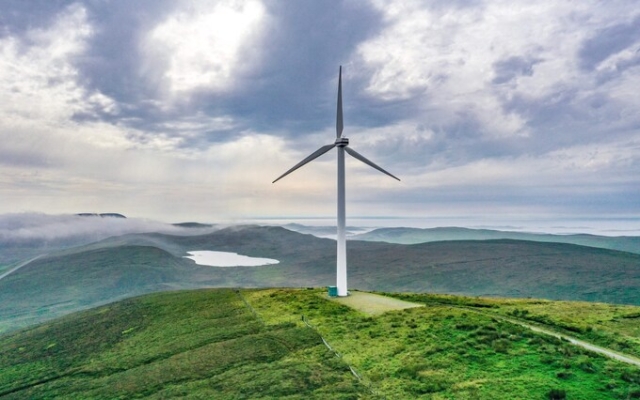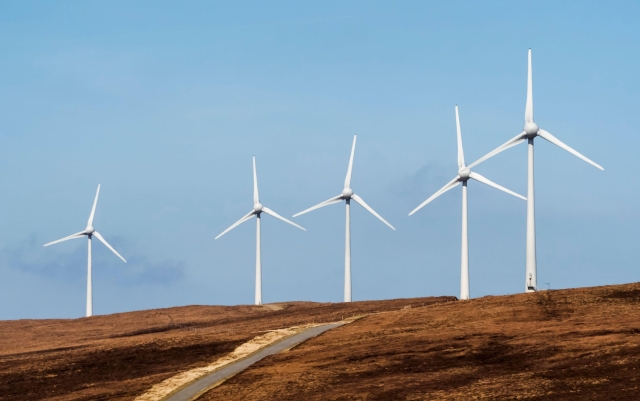 Viking has over 100 turbines spread across Shetland, each 155 meters high. Photo: WILLIAM EDWARDS/AFP
Viking has over 100 turbines spread across Shetland, each 155 meters high. Photo: WILLIAM EDWARDS/AFP
Gary Buchan stands outside his home and counts how many wind turbines have grown on the swamps and hills he sees from his living room window on a clear day.
«.. .25, 26, 27,” Buchan says. The 53-year-old man sighs. “This is what I see from my house.”
Completed last week, Viking is one of the largest offshore wind farms in the UK, with 103 turbines scattered across an area of about 50 square miles.< /p>
It was also built in one of the smallest and most remote parts of the country, the Shetland Islands.
High above the surrounding landscape, each turbine is 155 meters high from base to tip — one and a half times the height of Big Ben.< /p>
Right now, these sleeping giants sit idle, waiting to be turned on, highlighting the state of change the Shetlanders are in.
With the local oil and gas industry in decline and a plethora of clean energy companies looking to fill the void, residents have to grapple with some tough questions about their future.
The islands are the windiest place. in the UK, creating huge potential for onshore and offshore wind farms. Similarly, developers believe that abandoned land and ports formerly used for oil and gas production could be ideal places for new sites to store carbon and produce clean hydrogen.
 The transition to green energy comes with trade-offs, not least the impact on previously untouched landscapes in the archipelago. Credit: SJ Images/Alamy Stock Photo
The transition to green energy comes with trade-offs, not least the impact on previously untouched landscapes in the archipelago. Credit: SJ Images/Alamy Stock Photo
The transition to green energy, however, comes with trade-offs, not least the impact on the archipelago's previously untouched landscapes. As a result, some residents felt powerless in the face of seemingly insurmountable developments.
“People open the back door or the curtains and see a lot of turbines,” says Buchan, a fish farm technician and photographer who has been photographing the local environment for years.
“It's a beautiful sight. valley, and it ruined the view.”
Supporters of these projects say that the prosperous life that the islanders are accustomed to — well-groomed public services, near-full employment, and even Christmas bonuses for retirees at one stage — can only continue if they take advantage of clean energy opportunities.
“It’s about employment, about our own energy transition and trying to figure out how we can be more efficient as a society,” says Douglas Irvine, Head of Future Energy at the Shetland Islands Council.
Locals authorities are promoting plans to turn the archipelago into a renewable energy hub. Officials are also trying to ensure that the islanders benefit from the deployment of infrastructure.
For example, despite Shetland's status as a major oil and gas hub since the 1970s, the islands lack a gas network and a large proportion of households are languishing. in the fuel shortage.
“More than eight billion barrels of oil have been processed here, and this has made a huge contribution to the UK Treasury, but we are still facing the highest fuel bills,” explains Irwin. “This is an opportunity to make a difference.”
However, in the case of the Viking, which was developed by Scottish and Southern Electricity (SSE), the transition was far from easy. The islanders argued bitterly over both the environmental impact of the project and the perceived benefits of the project to the rest of Britain, not local residents.
The construction involved digging a deep concrete foundation in a previously undisturbed peat bog and the construction of new access roads, whereby the turbines dominated the views from nearby houses.
The size and capacity of the project is 443 megawatts, enough to power 500,000 homes a year. which dwarfs Shetland's own 10,600 — is also annoying as it means that most of the electricity generated will be exported via an undersea connecting cable to mainland Scotland.
1808 Domestic electricity decline
A taxi driver passing by Viking on Monday grumbled that this meant that power could even be in the hands of «Englandshire».
The dispute has divided neighbors and family members, some of whom no longer communicate with «This wind farm will produce about nine times the amount of electricity needed in Shetland,” he adds. «So export is the main driver.
“The council said that if the people of Shetland did not want it, it would never happen. But they never had a full-fledged referendum, and most people opposed it in consultations, which caused a lot of outrage.”
SSE notes that more than 30 permanent jobs have been created through the scheme. and says it has invested £70m in local supply chains.
Heather Donald, Head of Project Approvals at SSE Renewables, says the company aimed to minimize Viking's visual impact as much as possible, but admits the scheme is out of necessity suggests a compromise.
“If we are going to achieve decarbonization as fast as we need to, it will ultimately mean building projects in windy places,” she says.
She notes that Viking will almost single-handedly make Shetland carbon-intensive. Free «one flick of a switch» when turned on. «This is an example of what we think could happen elsewhere in the UK.»
Other businesses with existing projects or proposals in development include local firm Shetland Aerogenerators and Norwegian state-owned energy giant Statkraft. A consortium of companies known as Energy Isles supports development «for the benefit of the economy and society».
But the transition to zero net income means more than wind farms for Shetland.
North of Viking, on the main island, changes are also taking place at the Sullom Vo oil terminal, where oil from nearby wells is stored. The site is owned by a group of 13 oil companies, and since 2018 it has been managed by EnQuest, which bought out part of the shares from BP. The Sullom Vou terminal was considered a declining asset only five years ago, but now it could become one of the most promising abandoned oilfields in Europe
Salman Malik, chief financial officer of EnQuest, says that just five years ago this facility was considered a falling asset, but now it could become one of the most promising existing facilities in Europe.
“The winds have changed dramatically,” he says . “The move to clean energy has made Sullom Vo much more valuable and interesting than we or perhaps BP thought at the time of the original deal.”
Oil processing will continue at this facility for some time. , especially from the western Shetland Basin. At the same time, large sections of Sullom Vaux will be repurposed for carbon storage and hydrogen production, possibly along with its derivatives such as synthetic methane.
EnQuest has already received four carbon storage licenses from the UK government, including including at its Magnus oil field, where the company will pump carbon dioxide into devastated oil and gas reservoirs through pipelines already running between the fields and the terminal.
Sallom Vo also boasts four deep water berths up to 24 meters deep, meaning it could become a major hub for ships carrying CO2 from various locations across Europe.
According to Malik, it could potentially store 10 million tons of CO2 per year and up to one billion tons over the lifetime of the facility. The International Energy Agency and the UK Climate Change Committee see carbon storage as essential to achieving global climate goals.
“We are seeing a change where energy security is one of the issues and decarbonization is absolutely essential, and we want to be at the forefront of that,” adds Malik.
If EnQuest decides to move forward, it expects to start injecting carbon into late 2020s, possibly as early as 2028. A small demonstration hydrogen plant could be built by the middle of this decade.
The power plants are expected to be powered by nearby onshore and offshore wind farms such as Viking, which is expected to come online next year.
2105 Zero Path Electricity Generation
For now, Viking&# 39;s turbines are idle awaiting completion of work on a 600 megawatt submarine interconnection that will link Shetland to the national grid, allowing electricity to flow in and out of Scotland.
Emma McDonald, who chairs the council, acknowledges that people are concerned about the scale of development, but believes that opinion will change if the islands can provide tangible benefits.
She advocates that residents receive the Shetland Tariff. ” – cheaper electricity bills – in exchange for hosting infrastructure.
“When you look at how much energy will be produced, the fact that residents will still pay the highest heating costs to their people really hard to understand,” she adds.
“In my opinion, a realistic vision of the benefits could have a significant impact on how some people feel about the Vikings.”
>
At the moment many islanders remain skeptical that they will see the benefits of the coming green revolution.
«Honestly, it lined the pockets of many people who did not need it, and it did us no good,» Buchan says, looking at the turbines from his house.
“I don't like it. But in the end, you realize that things will go further, and there is nothing you can do about it.”























































Свежие комментарии